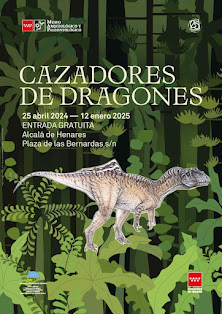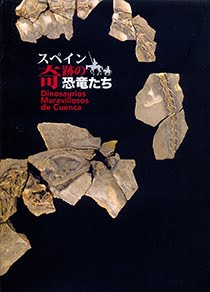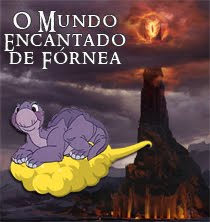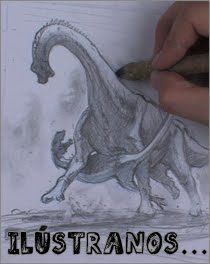Durante la XXII Bienal de la RSEHN celebrada en Coimbra (Portugal) se presentó un análisis de la diversidad de allosauroides conocida a partir del registro fósil del Jurásico Superior portugués. Este registro incluye diversos ejemplares que representan una gran diversidad, aunque con una posición filogenética problemática, lo que dificulta la interpretación paleobiogeográfica de este grupo de terópodos. Con todo, la interpretación de algunos taxones de terópodos como formas exclusivas del registro portugués y la reinterpretación de diversos ejemplares (previamente considerados como pertenecientes a especies compartidas con el registro de la Formación Morrison) como formas exclusivas de la cuenca lusitánica, sugiere procesos de vicarianza incipiente en la evolución de las faunas de terópodos del Jurásico Superior en ambos lados del proto-Atlántico Norte. El resumen es el siguiente:
Allosauroidea is a clade of large-bodied theropod dinosaurs that ranged from the Middle Jurassic to the Late Cretaceous (Brusatte & Sereno, 2008). This clade includes the Late Jurassic theropod Allosaurus, which is a well-known dinosaur genus, represented by hundreds of specimens from the North American Morrison Formation. Allosauroids represent an important group for the study of the Mesozoic palaeobiogeography because they comprise a long-lived and diverse group that evolved during the fragmentation of Pangaea (e.g. Pérez-Moreno et al., 1999; Sereno, 1999a,b; Upchurch et al., 2002).
The fossil record of allosauroid theropods from the Upper Jurassic of the Lusitanian Basin is abundant and diverse. Currently, this record includes Lourinhanosaurus (Mateus, 1998), Allosaurus (Pérez-Moreno et al., 1999; Mateus et al., 2006), and some specimens with an uncertain phylogenetic position that share some features, but also differences with Lourinhanosaurus and Allosaurus (Malafaia et al., 2016). Lourinhanosaurus antunesi is represented by a set of postcranial elements collected in Peralta (Lourinhã). It was originally described as an allosauroid (Mateus, 1998) and latter interpreted as a more basal tetanuran closely related with megalosaurids (Mateus et al., 2006). Subsequently, it was recovered as a member of the basal allosauroid clade Metriacanthosauridae by Benson (2010) and as a possible coelurosaur by Carrano et al. (2012). A recent phylogenetic analysis including some theropod specimens from the Upper Jurassic of Portugal supports the interpretation of Lourinhanosaurus as a member of Allosauroidea, but placed this taxon at the base of a more derived group comprising Allosaurus + Carcharodontosauria (Malafaia et al., 2016).
Allosaurus is the most abundant and well represented allosauroid taxon currently known in the Lusitanian Basin. This taxon is represented by a set of cranial and postcranial remains found in Praia de Vale Frades (Lourinhã), Andrés (Pombal), and Guimarota (Leiria) (Pérez-Moreno et al., 1999; Rauhut & Fechner, 2005; Mateus et al., 2006; Malafaia et al., 2010). A specimen collected in Andrés was assigned to the species Allosaurus fragilis described in the Morrison Formation. This specimen is the first evidence of Allosaurus outside North America and was considered in that moment the first dinosaur species present in two continents. This discovery triggered an intense discussion concerning the paleobiogeographic relationships of Late Jurassic dinosaur faunas from the Lusitanian Basin and the Morrison Fm. The presence of A. fragilis in both continents was interpreted as an evidence of faunal interchanges across the North Atlantic Ocean during the Late Jurassic. Later, a partial skull collected in Praia de Vale Frades was interpreted as belonging to a new Allosaurus species: Allosaurus europaeus (Mateus et al., 2006). In 2005, several osteological remains assignable to Allosaurus were found in the Andrés fossil site, including abundant cranial elements. These specimens show some differences when compared with A. fragilis, but also with the holotype of A. europaeus. The currently known Upper Jurassic record of allosauroid theropods from Portugal includes a relatively large number of specimens with a great diversity, but with an uncertain phylogenetic position, which difficult the study of the paleobiogeography of this group.
The identification of some theropod taxa interpreted as exclusive from the Portuguese record and the reinterpretation of several specimens previously considered as species shared with the Morrison Fm. as forms exclusive of the Lusitanian Basin suggest an incipient vicariant evolution of the Late Jurassic theropod faunas from both margins of the proto-North Atlantic Ocean.
Referencia:
- Malafaia, E., P. Mocho, F. Escaso, F. Ortega. 2017. The fossil record of Allosauroidea (Dinosauria, Theropoda) from the Upper Jurassic of the Lusitanian Basin: diversity and paleobiogeographic interpretation. XXII Bienal de La Real Sociedad Española de Historia Natural. Libro de Resúmenes 246–247.




































- Síguenos en Twitter
- "Síguenos en Facebook
- RSS
Contacto